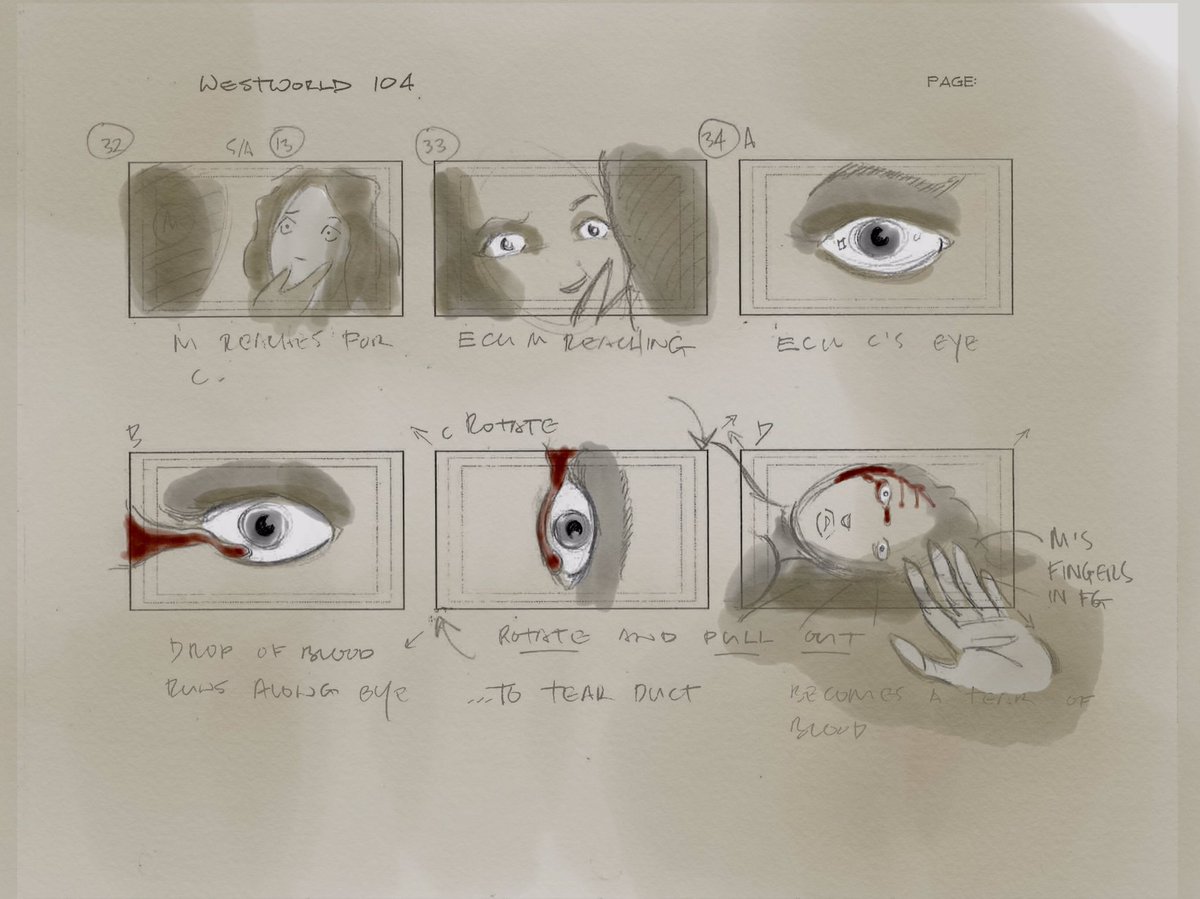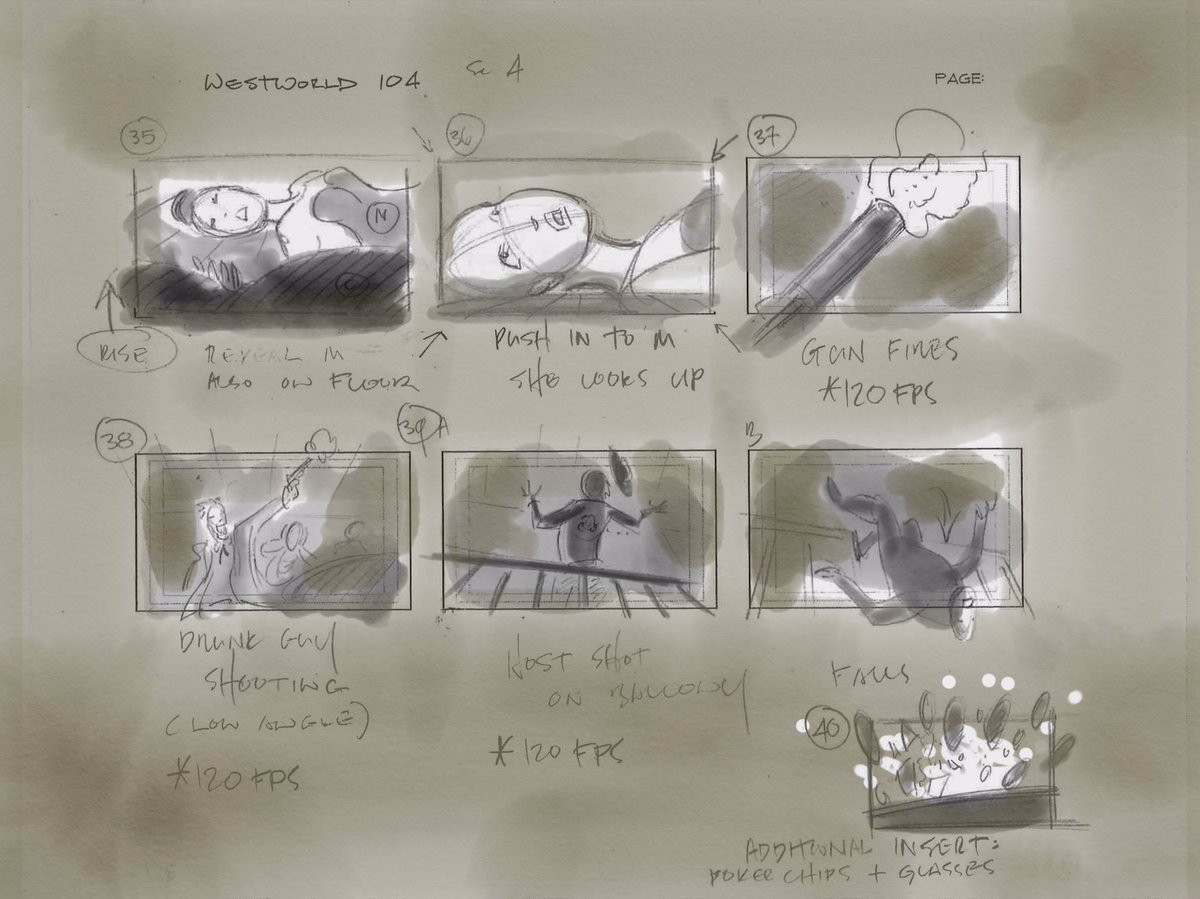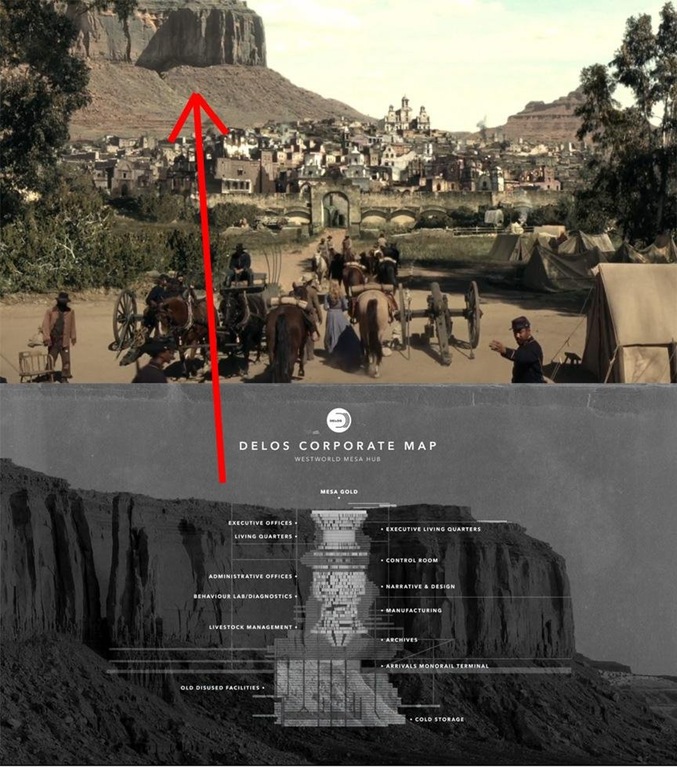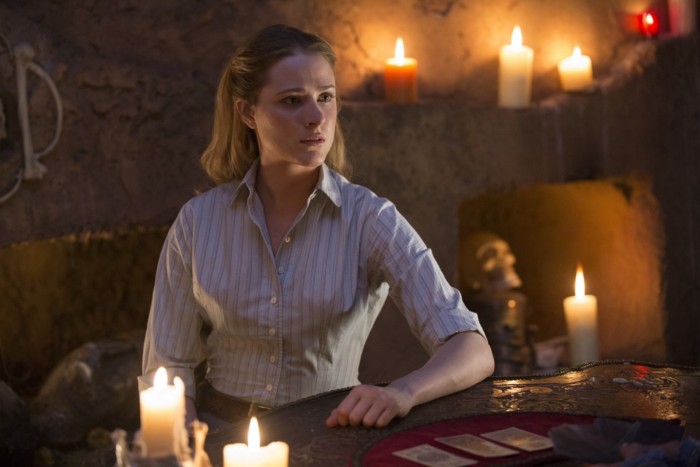Westworld Bits: Westworld's Chronology Explained, Storyboards, And Everyone Talks About The Orgy Scene
In this edition of Westworld Bits:
It's becoming increasingly obvious that the first season of Westworld is taking place on two separate timelines, following one group of characters in the past and another group in the future. And while you can disappear down a few Reddit rabbit holes and go really nuts with the details, this video from The Outline does an excellent job of explaining the basic shape of this theory and how everything fits into place. Until someone inevitably cuts together a chronological version of this season, this will have to do.
In #Westworld, even logos deserve a deeper look.
Open the door at https://t.co/JiVuKcf7D2.— Westworld (@WestworldHBO) September 30, 2016
HBO sent out that tweet before the first episode of Westworld even premiered and as that video above showed us, the changing logos of Westworld do tell an interesting story, acting as markers for where we are in the timeline. In other words, you have HBO's permission to really dig into this. Go nuts.
And Redditor machine_made has, indeed, gone nuts. That is a tentative timeline for the events of Westworld (done in the established Delos house style, no less), attempting to wrangle together 30 years of park history based on what we already know. There are huge gaps and certain aspects of it may have to change as we learn more, but this is an excellent start.
Genevieve Burgess at Pajiba has written an interesting look at how Westworld hasn't taken advantage of its setting to explore female sexuality. While characters like Logan are seen sleeping with every robot prostitute they come across, the show has yet to really explore how a woman would engage with the Hosts in a consequence-free environment. Here's an excerpt:
It's been made clear that there are male hosts whose job is to sexually service guests. Except that the only guest we've seen them service is Logan. While I appreciate including non-hetero sex in the show, it seems somewhat conspicuous that female guests availing themselves of male hosts has not been shown. We overheard a conversation between two female guests on the train in the first episode about hooking up with hot cowboys and bandits, but nothing came of it. We've seen a lady guest getting to be a big damn hero and taking a prostitute to bed afterwards, but it was Clementine. Why not have her request her "reward" from Teddy? On the spectrum of sexuality, most women are primarily attracted to men. But so far we've only seen sexually tinged interactions between two women whether unsuccessful (Maeve) or successful (Clementine). The story of how men express their sexuality when the chains come off has been dealt with time and time again, often in ways I'd find insulting if I were a man. The only barrier to push there is with how distasteful can they make it. But there has NEVER been a time or place in history when having sex as a woman was free of consequences and Westworld could have taken things there.
The whole thing is worth a read and it reaches a fascinating (and saddening) conclusion. For men, the fantasy of Westworld would be the chance to screw as many women (albeit, robotic women) as possible. For women, the fantasy would be a world where every possibly sexual partner would be part of a carefully maintained safe space.
Yesterday, the first official tracks from the Westworld soundtrack arrived on iTunes and I pondered whether or not the song choices were a reflection of the show's themes or simply pop hits selected by park. Vulture also wondered this and spoke to composer Ramin Djawadi about the use of The Cure's "A Forest" as one of the show's anachronistic player piano tunes. And yes, we are supposed to wonder about the use of each song:
Without giving too much away, Djawadi agreed that there are various possibilities as to why this song would be played in this situation. "One, it could be somebody going, 'I really want to listen to this song, even if the guests don't recognize it.' Selfish programming," he said. "Or is there a deeper meaning, with the title, the lyrics?"
Another possibility suggested in that article – what if the songs are part of the Host's programming, with the unheard lyrics keeping them in line or feeding them subliminal instructions?
Vincenzo Natali, the director of Westworld's fourth chapter "Dissonance Theory" (as well as movies like Cube, Splice, and Haunter), shared his storyboards for one of his episode's key sequences: Maeve (Thandie Newton) experiencing a violent flashback to one of her many deaths. While some storyboards are beautifully drawn and composed and exist to sell a specific tone to everyone working on a film, these storyboards are just plain practical, clean reference drawings covered with pencilled notes explaining where the camera needs to be for each moment. You can explore them for yourself in the gallery below.
Garner Holt, whose Garner Holt Productions, Inc. specializes in creating animatronics, props, and special effects for theme parks, recently wrote about one his company's most interesting ventures yet: contributing various pieces of equipment from around their shop to fill out Westworld's laborites. As he explained in his column at MiceChat:
Being asked to be part of something as iconic for "animatronics" as Westworld was a once-in-a-lifetime opportunity. Veteran film set decorator Scott Jones (Apollo 13, A.I., The Dark Knight Rises, among many others) came to GHP to take a look at things we had around the shop that might be good elements for a detailed lab set for the new series. He selected a number of animatronic figures that we use for demonstration purposes and trade shows (a couple of humans, a mule deer, a sparrow, and others), plus some mechanical bits and pieces that would look cool in a set designed to portray a lab where animatronics are built and repaired. When it came time to give a price for renting our equipment, I told Scott we had two prices: a higher one for just the figures, and a lower one for the figures...and a walk-on role on the episode of the show where our items appear for me and my creative director, Bill Butler. We were thrilled that HBO decided to go with the lower price!
I love this story for two reasons. First, I love that they gave HBO a discount so they could appear on the show, which is just so wonderfully nerdy. Second, it just makes me happy to know that some of the "futuristic" robots and objects seen around the Delos labs are from a company making actual theme park technology in 2016. Holt's story also touches on their day on set, lingering to discuss a meeting with Anthony Hopkins:
The highlight of our day was when a special guest arrived on the set: one of the stars of the series, Sir Anthony Hopkins. He was impressed with our animatronics on set, and generously spent some time chatting with us about our work and the scene. Meeting a legend like Tony (as he asked to be called) was incredible, a once-in-a-lifetime experience I'm grateful for and will never forget! Being part of a show like Westworld is something I would never have dreamed of as a kid watching the original, and I can't wait to see how the new series plays out. You can see our animatronics in the trailer, particularly the animated hand near the end. It's almost surreal to be a small part of show like that, sort of like coming full-circle.
 Variety has posted an excellent interview with Evan Rachel Wood, whose increasingly self-aware Dolores has evolved into the closest thing the Westworld ensemble has to a leading character. The whole thing is worth your time (Wood is about as smart and funny and insightful as you'd hope), but I particularly enjoyed this bit where she discussed first getting the part and not really understanding what kind of show Westworld was until halfway through the first season:
Variety has posted an excellent interview with Evan Rachel Wood, whose increasingly self-aware Dolores has evolved into the closest thing the Westworld ensemble has to a leading character. The whole thing is worth your time (Wood is about as smart and funny and insightful as you'd hope), but I particularly enjoyed this bit where she discussed first getting the part and not really understanding what kind of show Westworld was until halfway through the first season:
Oh my god — I had no idea, man. I knew I was going to be a part of this really amazing HBO show about robots. I knew that Jonah and Lisa were incredible and J.J. Abrams was amazing. They gave me a really brief rundown of Dolores and told me she had a really incredible arc and told me that she wouldn't necessarily stay the innocent prairie girl. But I had no idea until around episode five what show I was really on and what character was entrusted to me. And I was honored and felt very privileged to play her. She's a great character for women on-screen and I just loved playing her. She's my favorite character I've ever played.
They pitched it to me, and they said, "We want this to be the greatest show of all time." And I said, kind of writing it off, "Oh, yeah. Don't we all? Isn't that the goal? Ha ha ha." And then halfway through the season I realized they might not be kidding, and this may be one of the best shows we've seen in our generation. And I almost had a panic attack.
It's interesting that Wood specifically mentions episode 5 as being a key turning point for her offscreen, because "Contrapasso" also represents a key turning point for Dolores onscreen. In that episode, she not only changes out of that Disney princess blue dress, she guns down a handful of Confederados to "save" Jimmi Simpson's William and declares that she has decided to no longer be the damsel. It's a memorable and empowering moment for a character who has been so often brutalized. As Wood explained in the interview, Westworld is critical of the sexual violence that occurs on screen and just-off-screen, using the casual horrors of the show to make a bigger point:
Which I thought was interesting because there are no scenes of rape. It's all implied. Early on when we were getting that criticism, I just encouraged people to stick with it and wait for the context, because obviously that was the starting point, and it's so we have a place to go to show the motivation of this character — and also a conversation about rape culture and what's acceptable and entertaining and what has become the social norm. We are making this up, but if this park really did exist, there really are those people who would come in and do that for fun. I think we're really examining that — not in a gratuitous way, but in a way that really looks at the crime and the pain that's inflicted and gives us all sides of it. It's not just a device or there to be gratuitous. It really is there for a reason, to send a message, and for us to take a good hard look in the mirror to understand it more and to not write it off.
You have an obligation as an artist sometimes, where you're left with the question of do we perpetuate this and put it out into the world, do we censor it, or do we show it for what it is? And there's also something to be said for showing it so that people don't get desensitized and they are traumatized by it and see it for what it is, which is a horrendous act. We also have responsibilities to not whitewash over it. And I think that's the angle that Westworld takes with it. And that's why I was okay with it. As somebody who advocates for victims of sexual assault and a survivor myself, I never would do anything that I felt was gratuitous or fed into that in any way.
You can read the whole interview at the link above.
Redditor cool_hand_luke has made an interesting discovery about Westworld's park layout. It seems that the official image of the Delos hub (where Dr. Ford, Bernard Lowe, and the rest of the park employees live and work) aligns with the cliffs just beyond the bloody and debauched city of Pariah. I had just assumed that park ops would be centralized, located somewhere in the vicinity of Sweetwater, where guests first arrive on the train, but nah. They're out in the fringes, with the really weird stuff.

Very important trivia: did you know that the people in Westworld aren't actually wealthy future tourists and robots, but are really actors playing roles? Crazy! For proof of this, the craziest fan theory yet, here's this behind-the-scenes photo showing Evan Rachel Wood, Jimmi Simpson, Ben Barnes, and James Landry Hébert (who initially shared the photo on his Twitter feed) hanging out between takes.
 Vulture spoke to Jimmi Simpson, who playsWestworld's resident "white hat" William, and you bet they started things off by asking about that orgy scene in "Contrapasso":
Vulture spoke to Jimmi Simpson, who playsWestworld's resident "white hat" William, and you bet they started things off by asking about that orgy scene in "Contrapasso":
Yeah, of course. It's bizarre, dude! They send out the flyers saying, "Hey, would you get naked on film?" Then the people that are there that night are all the people that said, "I will." It's a bunch of proud, naked, human adults, in a room together. Some are made-up, some have gold genitals even, or are wearing masks of animals. They're all there, and they're glad to be there. It's just like they were all wearing T-shirts and jeans, but instead of T-shirts and jeans, they had naked bodies.
The interview eventually branches out into more areas of the show, with Simpson even explaining the actors would gather between takes to discuss their own theories to devise what's actually going on in the show (Actors! They're just like us!). He also explained what it's like to play a character when so much backstory and so many truths are deliberately kept in the dark:
I think it's much more natural. It was way more conducive to creating a three-dimensional character for me. Generally, of course, you're going to read the script; the script is where you have all of your keys and your clues as to who the person is. You read the whole thing, and you know where the person goes. The task of an actor is generally to not play the end of their arc, to not know what's going to happen, and to fool that audience into believing that you are going along, having no idea. If you have a great ending or a terrible ending, this character needs to be clueless of that fact. All of these actors [in Westworld] were clueless as to where it's going to end up, and I think it made for a really rich garden for in-the-moment work from all these really top-notch actors.
You can read the whole interview at the link above.
Meanwhile, Entertainment Weekly asked showrunners Jonathan Nolan and Lisa Joy about that orgy scene, which may contain more nudity than any other sequence in TV history (you can hear Game of Thrones mutter "challenge accepted" if you listen closely). Nolan described what it was like to craft a scene like this:
This is new territory for Lisa and myself. I'm English, so we don't do this kind of stuff, and it hasn't been a prominent feature of the movies that I've worked on. The nudity in the show — and [Entertainment Weekly] as well as others have correctly identified — in most episodes is not supposed to be titillating. It's about humanizing the hosts, it's about control. This is the one episode where we were going for it — to show the pure pleasure of this place. But we used the same rule-set that we've used throughout, which is to run a closed set where we wanted the set to be as respectful as possible to the actors and background performers who are literally baring it all for these scenes. I think everyone had a good time and it was done as respectfully and carefully as possible. And that scene in Pariah was hugely ambitious and beautifully shot.
Joy added her own perspective on shooting the scene, noting that shooting sexy scenes isn't an especially sexy process:
I was on set the whole time for that. For me, I get a little shy around this stuff sometimes. It's very strange, you're looking at the actors coming in for these roles and you have to do a wardrobe test. In this case you're not testing clothing so much, it's what we call the "furry bikini" — they put on a merkin and you look at the way their [body] paint is laid out. I think people imagine when something is sexy on screen that it might be sexy on the day, but it's not. It's a bunch of people putting on robes and going to craft services and staying warm, and then doing their thing. But the actors were incredible, and we had a sex consultant on set to make sure everybody felt comfortable and to make sure the scenes were looking sexy enough, and I think that helped.
The whole interview, which eventually does get beyond that orgy, can be read at the link above.













